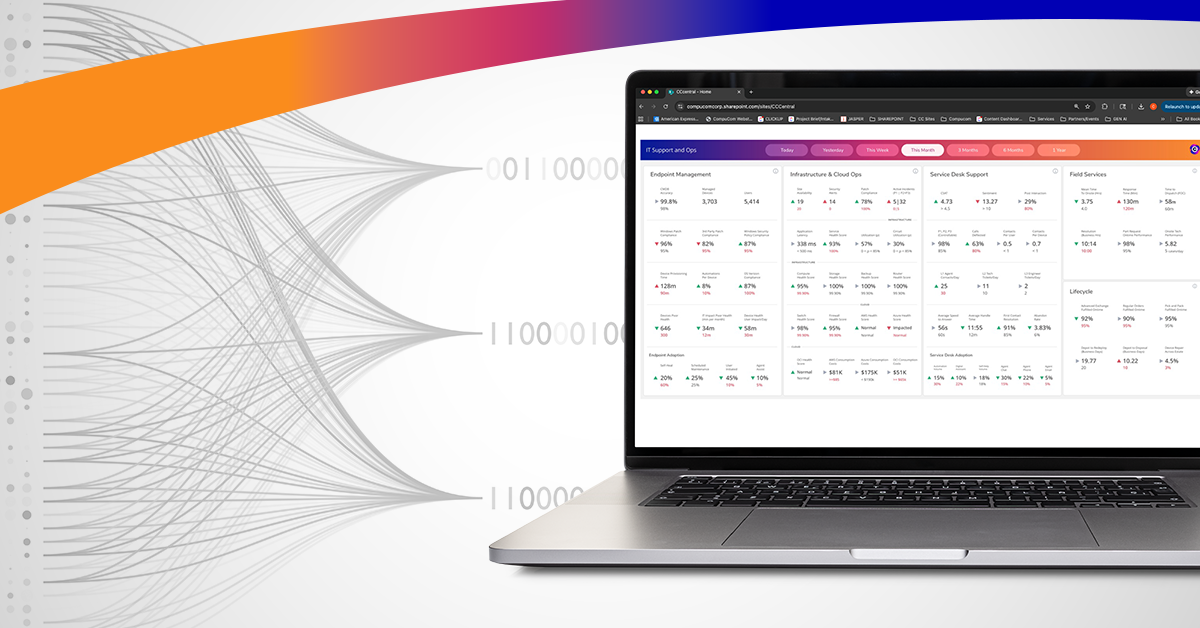- Managed Services and IT Support
- Advanced Technology

SNAPSHOT: Whether your company has landed on remote work, hybrid setups, or return to office (RTO), each model presents unique IT challenges. We recommend letting strategic optimization be your guiding star, armoring your company against volatile changes. Here, we delve into the reality of modern workplace structures. We’ll explore how to ensure your IT infrastructure is fine-tuned to thrive AND support long-term success, finding opportunity as you navigate ongoing economic uncertainty.

Emma Mak • Staff Writer
Long-Term Work Structures and the IT Implications
Long-term work structures have solidified over 2023 and 2024. As of 2025, 36% of enterprise workers in North America are hybrid/remote, while the rest are back to full-time office schedules.
While there continues to be a lot of back-and-forth about which work model fosters better productivity, the truth is, regardless of your company’s final work setup, the transition hasn’t been easy and there’s likely been some impact for your IT environment.
Adding to the complexity, in early 2025, the Global Economic Policy Uncertainty Index reached its highest level this century — creating a challenging business landscape that necessitates a strategic approach to IT infrastructure to ensure resilience and adaptability.
We’ve pinpointed four major IT pain points related to work setups that companies are facing:
- Unsuitable network architecture
- Inefficient cloud vs. on-prem balance
- Connectivity and collaboration issues
- Inadequate office setup and print infrastructure
The silver lining: By proactively addressing these pain points, your company can significantly enhance its operational efficiency, giving you a strategic advantage over your competitors.
Pain Point 1: Unsuitable Network Architecture
Remember the mad scramble five years ago to get everyone set up with laptops, switch to SD-WAN, and create a decentralized workforce practically overnight? In the rush, most infrastructure setups weren’t designed to last. Many of you are asking if your company’s reliance on SD-WAN, which is more complex to manage and troubleshoot, is still appropriate.
Solution: Enhance Network Resilience and Adaptability
Here’s the deal: moving to SD-WAN was likely the right move, as it offers flexibility, scalability, and cost efficiency. However, your network shouldn’t remain stuck in 2020. It’s 2025 – are you using best practices for network management to maintain security, performance, and user satisfaction? We can help evaluate and optimize existing network setups by:
- Conducting thorough infrastructure assessments.
- Identifying bottlenecks.
- Implementing tailored solutions that align with current business needs.
To significantly enhance the resilience of your company’s SD-WAN, consider adopting a Secure Access Service Edge (SASE) security framework. It integrates multiple security functions and provides users with secure and seamless access to applications and resources from anywhere.
A key component and enhancement to SASE is the Zero Trust Network Access (ZTNA) security model. Unlike traditional security models that rely on a perimeter-based approach, ZTNA operates on the principle of “verify explicitly, use least privilege, and assume breach”.
ZTNA and SASE help you to:
- Reduce unauthorized access risks with identity-driven, context-aware application access.
- Integrate networking and security into a single cloud-native service, simplifying complexity and reducing cost.
- Scale with business needs, providing secure access to applications and data anywhere.
Solutions implementing these frameworks can help companies update their SD-WAN and build a more resilient and adaptable network infrastructure. In partnership with Cisco, Palo Alto Networks, Fortinet, and other vendors, we will help you implement a tailored solution for your business, achieving a network that’s robust, faster, and built to stay ahead of your needs — and get you ready for whatever comes next.
Pain Point 2: Inefficient Cloud vs. On-Prem Balance
During the height of remote transformations, with limited options and an urgent need to maintain business continuity, organizations lifted applications to the cloud – fast and without much room for debate. Unfortunately, not every application belongs there. The two main concerns being cost and security.
Cloud solutions have not proven to be as universally cost-efficient as initially hoped, leaving companies burdened with inefficiencies and higher-than-expected costs.
Although continuing migration to the cloud and cloud workloads (especially with AI-related public cloud services blossoming) are greater than “repatriated” workloads, over one-fifth (21%) of workloads have been brought back to companies’ data centers.
Solution: Smarter Workload Placement
Not everything needs to live in the cloud, and that’s okay. By taking a step back and assessing your workloads, we can cut through inefficiencies and figure out what belongs there.
Sensitive or high-performance applications? Maybe those are better off on-prem where you have tighter control.
Cost-driving workloads? We can help you chart a path to optimize or even pull them back to save money without sacrificing performance.
We leverage several key partnerships to provide you the best solutions to optimize workloads, ensuring flexibility, scalability, and cost efficiency. Our vendor-neutral approach allows us to offer a diverse range of solutions, including:
- Hybrid Cloud Solutions: Microsoft Azure, AWS
- Infrastructure Optimization: VMWare, Cisco, Nutanix, Dell EMC
- Networking Solutions: Cisco HyperFlex, Juniper Networks, Arista Networks, Huawei
- Scalable Infrastructure: HPE GreenLake, Dell APEX
At the end of the day, making choices that actually work for your business is always the right move. Our approach isn’t cookie-cutter, it’s customized to meet your specific needs. We have experts ready to assist with every aspect of the technology procurement process. With long-standing partnerships with Tier One suppliers and relationships with more than 300 OEMs, we ensure the best solutions tailored for your success.
Pain Point 3: Connectivity and Collaboration Issues
Regardless of the work model your company has, a higher degree of flexibility is now the norm. Over 1 in 4 paid workdays in the U.S. were done from home in 2024, compared to just 1 in 14 from pre-pandemic days.
Even if your company isn’t officially hybrid, today’s employees want the flexibility to juggle appointments, work, travel, and family obligations, while still staying productive and connected with their teams.
It’s likely meetings at your company feature a mix of in-office and remote participants. Without the right setup, this can quickly descend into frustration with glitchy video meetings and disengaged team members.
Solution: Smarter Workload Placement
It’s vital to create a workplace where hybrid meetings are truly productive, bringing teams together, no matter where they’re based.
To ensure your technology meets the demands of hybrid meetings, ensure reliable video conferencing tools, adequate bandwidth, and robust collaborative platforms.
Here are some key strategies we can help you with:
- Unified Communications and Collaboration Tools: From video conferencing to file sharing and task management, these tools keep everyone on the same page.
- Optimized Network Performance: We can evaluate and upgrade your network infrastructure to ensure consistent bandwidth, minimal latency, and strong Wi-Fi coverage across all your locations.
- Cloud-Based Solutions: Cloud solutions enable real-time file sharing and updates, as well as extraordinary scalability.
- Enhanced Cybersecurity: Protect your communication channels with tools like multi-factor authentication and encrypted video calls.
Pain Point 4: Inefficient Office Setup and Print Infrastucture
The shift to a more flexible working environment has exposed cracks in traditional office setups that just don’t cut it anymore. Offices who reopened their doors are running into problems with legacy IT systems that can’t keep up with the demands of modern business.
Solution: Smarter Workload Placement
We take a no-nonsense approach to fixing inefficiencies. That means assessing your current systems, pinpointing issues, and rolling out modern solutions that work.
You may need targeted solutions, such as hardware refreshes to ensure equipment stays up to date and ready to perform, stronger cybersecurity measures to fend off evolving threats, or managed print services that eliminate unnecessary complexity and waste in office operations.
Our technology sourcing and procurement services leverage partnerships with leading technology providers including Apple, Dell, Cisco, HP, Lenovo, Microsoft, and more to supply the latest hardware and software solutions.
The payoff? A highly connected and productive workplace where employees, whether remote or on-site, can focus on smashing goals, not battling outdated technology.
And if printing is part of your operation — be it in corporate or customer-facing tasks — there’s a good chance your old, outdated print infrastructure is holding you back and eating into your profits.
Despite digital solutions enabling reduced printing and the number of pages printed dropping 20% since the beginning of the pandemic (primarily due to hybrid work), printing remains essential in some sectors such as finance, healthcare, and legal services.
With our Managed Print Services (MPS) we leverage strong partnerships including HP and Xerox to deliver a solution that can include cloud-based printing systems, automating workflows, and maintaining print devices to reduce downtime.
We’ll help you implement energy-efficient print systems, reduce paper waste, and ensure you’re using eco-friendly supplies — because sustainability isn’t just ethical, it’s smart business.
Compucom Helps You Pivot with Purpose and Precision
If the past few years have shown us anything, it’s the importance of keeping IT strategies flexible to support the way we work now, while planning for the future.
This is an opportunity to make your IT operations more flexible, scalable, and efficient – the ability to pivot with purpose and precision is key.
We specialize in helping you achieve operational excellence through cost-led optimization, ensuring you’re strategically positioned to thrive, no matter what comes next.
Don’t wait for change to happen to you; partner with Compucom to turn uncertainty into opportunity and solve today’s problems while building a flexible, cost-effective foundation that’s ready for growth.
RecenT

The Mac Management Playbook: 8 Steps to Deployment at Scale

Full Lifecycle, Full Visibility: Maximizing the Value of Mac in the Enterprise

Mac in the Enterprise — Myth vs. Reality: Debunking the Top Barriers to Adoption

Maturity Assessments Set a Clear Path to IT Modernization

Opportunity in Uncertainty: Leveraging Data for Fearless Decision-Making

Opportunity in Uncertainty: Turning 6 Top IT Challenges into Strategic Advantages
TOPICS
Opportunity in Uncertainty: Optimize Your Remote, Hybrid, or In-Office Setup
- Managed Services and IT Support
- Advanced Technology
SNAPSHOT: Whether your company has landed on remote work, hybrid setups, or return to office (RTO), each model presents unique IT challenges. We recommend letting strategic optimization be your guiding star, armoring your company against volatile changes. Here, we delve into the reality of modern workplace structures. We’ll explore how to ensure your IT infrastructure is fine-tuned to thrive AND support long-term success, finding opportunity as you navigate ongoing economic uncertainty.

Emma Mak • Staff Writer
Long-Term Work Structures and the IT Implications
Long-term work structures have solidified over 2023 and 2024. As of 2025, 36% of enterprise workers in North America are hybrid/remote, while the rest are back to full-time office schedules.
While there continues to be a lot of back-and-forth about which work model fosters better productivity, the truth is, regardless of your company’s final work setup, the transition hasn’t been easy and there’s likely been some impact for your IT environment.
Adding to the complexity, in early 2025, the Global Economic Policy Uncertainty Index reached its highest level this century — creating a challenging business landscape that necessitates a strategic approach to IT infrastructure to ensure resilience and adaptability.
We’ve pinpointed four major IT pain points related to work setups that companies are facing:
- Unsuitable network architecture
- Inefficient cloud vs. on-prem balance
- Connectivity and collaboration issues
- Inadequate office setup and print infrastructure
The silver lining: By proactively addressing these pain points, your company can significantly enhance its operational efficiency, giving you a strategic advantage over your competitors.
Pain Point 1: Unsuitable Network Architecture
Remember the mad scramble five years ago to get everyone set up with laptops, switch to SD-WAN, and create a decentralized workforce practically overnight? In the rush, most infrastructure setups weren’t designed to last. Many of you are asking if your company’s reliance on SD-WAN, which is more complex to manage and troubleshoot, is still appropriate.
Solution: Enhance Network Resilience and Adaptability
Here’s the deal: moving to SD-WAN was likely the right move, as it offers flexibility, scalability, and cost efficiency. However, your network shouldn’t remain stuck in 2020. It’s 2025 – are you using best practices for network management to maintain security, performance, and user satisfaction? We can help evaluate and optimize existing network setups by:
- Conducting thorough infrastructure assessments.
- Identifying bottlenecks.
- Implementing tailored solutions that align with current business needs.
To significantly enhance the resilience of your company’s SD-WAN, consider adopting a Secure Access Service Edge (SASE) security framework. It integrates multiple security functions and provides users with secure and seamless access to applications and resources from anywhere.
A key component and enhancement to SASE is the Zero Trust Network Access (ZTNA) security model. Unlike traditional security models that rely on a perimeter-based approach, ZTNA operates on the principle of “verify explicitly, use least privilege, and assume breach”.
ZTNA and SASE help you to:
- Reduce unauthorized access risks with identity-driven, context-aware application access.
- Integrate networking and security into a single cloud-native service, simplifying complexity and reducing cost.
- Scale with business needs, providing secure access to applications and data anywhere.
Solutions implementing these frameworks can help companies update their SD-WAN and build a more resilient and adaptable network infrastructure. In partnership with Cisco, Palo Alto Networks, Fortinet, and other vendors, we will help you implement a tailored solution for your business, achieving a network that’s robust, faster, and built to stay ahead of your needs — and get you ready for whatever comes next.
Pain Point 2: Inefficient Cloud vs. On-Prem Balance
During the height of remote transformations, with limited options and an urgent need to maintain business continuity, organizations lifted applications to the cloud – fast and without much room for debate. Unfortunately, not every application belongs there. The two main concerns being cost and security.
Cloud solutions have not proven to be as universally cost-efficient as initially hoped, leaving companies burdened with inefficiencies and higher-than-expected costs.
Although continuing migration to the cloud and cloud workloads (especially with AI-related public cloud services blossoming) are greater than “repatriated” workloads, over one-fifth (21%) of workloads have been brought back to companies’ data centers.
Solution: Smarter Workload Placement
Not everything needs to live in the cloud, and that’s okay. By taking a step back and assessing your workloads, we can cut through inefficiencies and figure out what belongs there.
Sensitive or high-performance applications? Maybe those are better off on-prem where you have tighter control.
Cost-driving workloads? We can help you chart a path to optimize or even pull them back to save money without sacrificing performance.
We leverage several key partnerships to provide you the best solutions to optimize workloads, ensuring flexibility, scalability, and cost efficiency. Our vendor-neutral approach allows us to offer a diverse range of solutions, including:
- Hybrid Cloud Solutions: Microsoft Azure, AWS
- Infrastructure Optimization: VMWare, Cisco, Nutanix, Dell EMC
- Networking Solutions: Cisco HyperFlex, Juniper Networks, Arista Networks, Huawei
- Scalable Infrastructure: HPE GreenLake, Dell APEX
At the end of the day, making choices that actually work for your business is always the right move. Our approach isn’t cookie-cutter, it’s customized to meet your specific needs. We have experts ready to assist with every aspect of the technology procurement process. With long-standing partnerships with Tier One suppliers and relationships with more than 300 OEMs, we ensure the best solutions tailored for your success.
Pain Point 3: Connectivity and Collaboration Issues
Regardless of the work model your company has, a higher degree of flexibility is now the norm. Over 1 in 4 paid workdays in the U.S. were done from home in 2024, compared to just 1 in 14 from pre-pandemic days.
Even if your company isn’t officially hybrid, today’s employees want the flexibility to juggle appointments, work, travel, and family obligations, while still staying productive and connected with their teams.
It’s likely meetings at your company feature a mix of in-office and remote participants. Without the right setup, this can quickly descend into frustration with glitchy video meetings and disengaged team members.
Solution: Smarter Workload Placement
It’s vital to create a workplace where hybrid meetings are truly productive, bringing teams together, no matter where they’re based.
To ensure your technology meets the demands of hybrid meetings, ensure reliable video conferencing tools, adequate bandwidth, and robust collaborative platforms.
Here are some key strategies we can help you with:
- Unified Communications and Collaboration Tools: From video conferencing to file sharing and task management, these tools keep everyone on the same page.
- Optimized Network Performance: We can evaluate and upgrade your network infrastructure to ensure consistent bandwidth, minimal latency, and strong Wi-Fi coverage across all your locations.
- Cloud-Based Solutions: Cloud solutions enable real-time file sharing and updates, as well as extraordinary scalability.
- Enhanced Cybersecurity: Protect your communication channels with tools like multi-factor authentication and encrypted video calls.
Pain Point 4: Inefficient Office Setup and Print Infrastucture
The shift to a more flexible working environment has exposed cracks in traditional office setups that just don’t cut it anymore. Offices who reopened their doors are running into problems with legacy IT systems that can’t keep up with the demands of modern business.
Solution: Smarter Workload Placement
We take a no-nonsense approach to fixing inefficiencies. That means assessing your current systems, pinpointing issues, and rolling out modern solutions that work.
You may need targeted solutions, such as hardware refreshes to ensure equipment stays up to date and ready to perform, stronger cybersecurity measures to fend off evolving threats, or managed print services that eliminate unnecessary complexity and waste in office operations.
Our technology sourcing and procurement services leverage partnerships with leading technology providers including Apple, Dell, Cisco, HP, Lenovo, Microsoft, and more to supply the latest hardware and software solutions.
The payoff? A highly connected and productive workplace where employees, whether remote or on-site, can focus on smashing goals, not battling outdated technology.
And if printing is part of your operation — be it in corporate or customer-facing tasks — there’s a good chance your old, outdated print infrastructure is holding you back and eating into your profits.
Despite digital solutions enabling reduced printing and the number of pages printed dropping 20% since the beginning of the pandemic (primarily due to hybrid work), printing remains essential in some sectors such as finance, healthcare, and legal services.
With our Managed Print Services (MPS) we leverage strong partnerships including HP and Xerox to deliver a solution that can include cloud-based printing systems, automating workflows, and maintaining print devices to reduce downtime.
We’ll help you implement energy-efficient print systems, reduce paper waste, and ensure you’re using eco-friendly supplies — because sustainability isn’t just ethical, it’s smart business.
Compucom Helps You Pivot with Purpose and Precision
If the past few years have shown us anything, it’s the importance of keeping IT strategies flexible to support the way we work now, while planning for the future.
This is an opportunity to make your IT operations more flexible, scalable, and efficient – the ability to pivot with purpose and precision is key.
We specialize in helping you achieve operational excellence through cost-led optimization, ensuring you’re strategically positioned to thrive, no matter what comes next.
Don’t wait for change to happen to you; partner with Compucom to turn uncertainty into opportunity and solve today’s problems while building a flexible, cost-effective foundation that’s ready for growth.
Recent Blogs

The Mac Management Playbook: 8 Steps to Deployment at Scale

Full Lifecycle, Full Visibility: Maximizing the Value of Mac in the Enterprise

Mac in the Enterprise — Myth vs. Reality: Debunking the Top Barriers to Adoption

Maturity Assessments Set a Clear Path to IT Modernization

Opportunity in Uncertainty: Leveraging Data for Fearless Decision-Making




